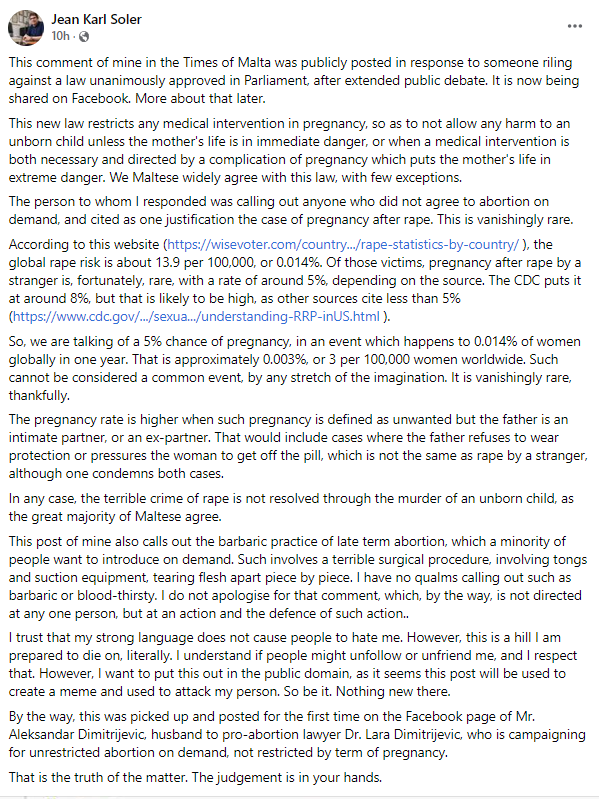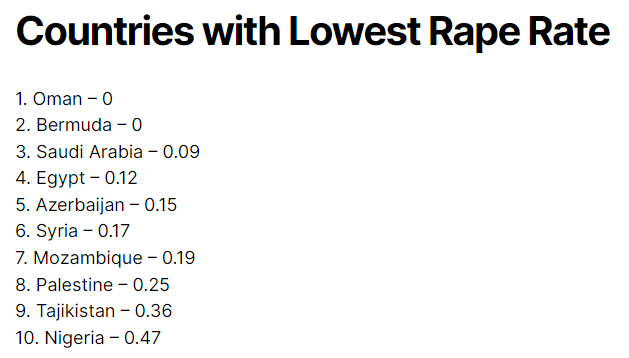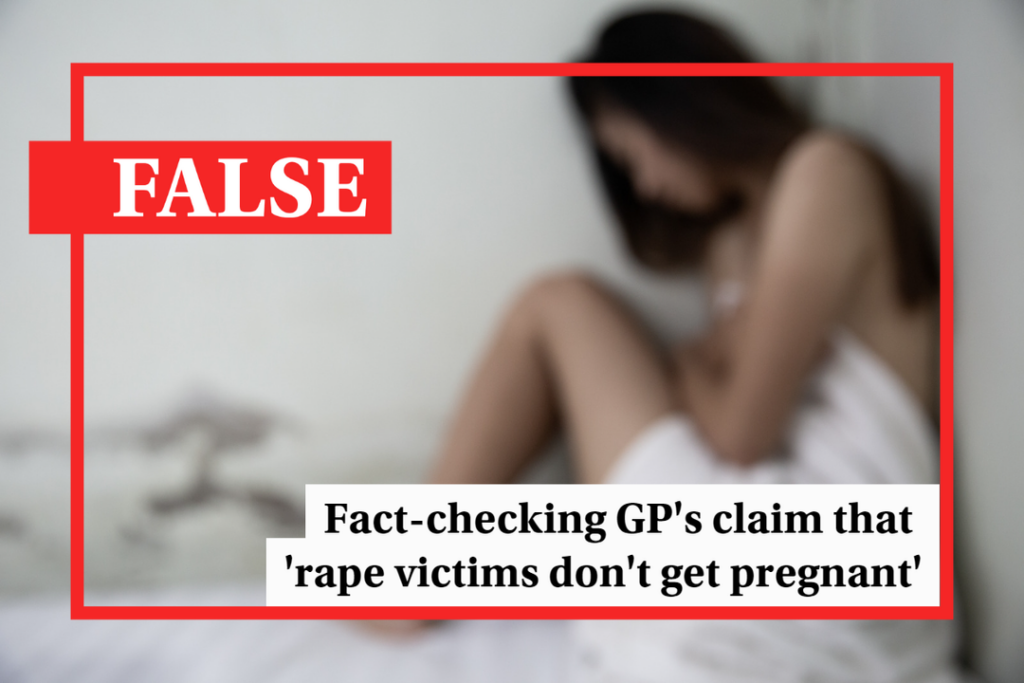Claim: Rape victims don’t get pregnant. Only 3 in 100,000 women worldwide become pregnant as a result of rape.
Verdict: This claim is false. Experts agree that rape incidents are drastically underreported and that true rape figures are much higher than official data shows. Using these figures to estimate the number of women who become pregnant through rape is misleading, as the true number is likely to be higher.
In a comment posted on the Times of Malta website beneath an article about a recently-introduced abortion bill, local doctor Jean Karl Soler said that “rape victims don’t get pregnant”, going on to describe the risk of pregnancy following rape as “vanishingly low”.
Soler was replying to a comment submitted by another reader who criticised the bill for ignoring the needs of rape victims whose rape results in pregnancy. In his comment, Soler said, “rape victims don’t get pregnant (sorry, facts are facts; based on CDC statistics such is extremely unlikely)”.

Soler rose to prominence during the COVID-19 pandemic, when his criticism of the government’s handling of pandemic measures earned him a significant following on social media.
Screenshots of his comments about rape were shared extensively on Facebook, most prominently by incensed pro-choice activists.
Soler, in turn, took to Facebook to explain that the global rape risk is just 13.9 per 100,000 women. Of these, Soler said, only 5% are likely to result in pregnancy, meaning that in practice only three in 100,000 women face the risk of pregnancy resulting from rape.

The belief that rape cannot, or is unlikely to, result in pregnancy has often raised its head in abortion debates around the world.
Versions of this claim have been traced back as far as 13th-century legal texts, but they have stuck around and are used to this day, with several US lawmakers, in particular, downplaying the risk of pregnancy as a result of rape.
Several readers asked Times of Malta to verify the true extent of pregnancy resulting from rape.
Are cases of rape really so low?
Only if we take rape statistics at face value.
Rape statistics are notoriously unreliable for several reasons, the most evident being the well-documented under-reporting of rape and other forms of sexual violence.
Some reports say that 60% of rape incidents go unreported, while others estimate the figure to be closer to two-thirds of all victims.
Other studies believe this to be far higher. UK official statistics from 2020 estimate that five out of every six women who are raped never file a police report. Meanwhile, research in Pakistan found that only 0.2% of rape victims report the crime, despite a woman being raped every two hours.
Whatever the true figure, experts agree that reported rapes are only the tip of the iceberg.
Even the source used by Soler, a US-based website called Wisevoter, makes the same argument, pointing out that “rape is an incredibly under-reported crime, meaning that many victims do not come forward to report due to fear of stigma or retribution”.
The 10 countries with the lowest rate of rape in the world according to Wisevoter’s data lists several countries with notoriously poor human rights records.
Oman, Saudi Arabia, Egypt and Azerbaijan all feature in the top five, with Syria, Nigeria and Tajikistan right below them. In presenting its data, Wisevoter warns readers that a low rate of rape “does not mean that rape incidents rarely happen in those countries, but rather that such incidents are not being reported”.

Even if rape reporting were more reliable, global rape statistics would still be problematic for several other reasons, not least the fact that what is legally defined as rape often varies across countries and cultures.
For instance, several countries around the world either do not recognise marital rape or explicitly exclude it from anti-rape legislation. Similarly, some countries only recognise rape in cases of penetrative intercourse, while others include other forms of sexual violence.
Likewise, stealthing – the act of removing a condom without the partner’s consent – is classified as rape in some countries, but not in several others.
These differences make it very difficult to develop consistent or reliable data around the issue.
While we may never know the true extent of rape around the world, what we certainly do know is that the true figure is much higher than the actual number of rapes reported.
What about Malta?
There is relatively little research into rape in Malta and accurate data about the prevalence of rape is hard to come by.
Malta’s criminal code defines rape as “non-consensual vaginal, anal, or oral penetration”. The law also prohibits marital rape, listing it as an aggravating circumstance that results in a harsher punishment for perpetrators.
Police data shows that there were 287 female victims of rape since 2008, with 37 cases reported last year alone, the highest annual figure recorded.
As in other countries around the world, rape is believed to be dramatically under-reported in Malta.
A crime victimisation survey carried out in 2015 by several leading local criminologists found that almost 86% of people who were victims of sexual assault, including rape, did not report the crime to the police.
The criminologists say that this is “understandable since most victims know their perpetrator” and may fear that reporting the crime could lead to further repercussions.
How common is pregnancy after rape?
Soler argues that around 5% of rapes are likely to result in pregnancy, saying that several sources present similar statistics when analysing the rate of rape-related pregnancy.
Soler is partly correct, although statistics on rape and pregnancy tend to vary wildly.
The most widely-recognised study in the field, a 1996 study published in the American Journal of Obstetrics and Gynecology, examined a sample of 4,000 women and found that there was a 5% chance of pregnancy after being raped. The study included cases of rape in which condoms were used.
Half the women in the study opted to undergo an abortion, while a third chose to see the pregnancy to full term and keep the infant.
The study concludes that “rape-related pregnancy occurs with significant frequency. It is a cause of many unwanted pregnancies and is closely linked with family and domestic violence”.
The US Centre for Disease Control estimates the true figure to be higher, saying that of the 18 million women who have experienced vaginal rape in their lifetime, almost three million experience rape-related pregnancy, a rate of roughly 16%.
A 1998 study into cases of rape amongst high school students in Ethiopia reached a similar conclusion, finding that 17% of rapes resulted in pregnancy, although this study is based on a relatively small sample.
Can we estimate the number of rape-related pregnancies?
No, the flawed and disputed data on the topic makes it almost impossible to reach a reliable estimate.
An analysis by Politifact attempted to figure out the number of rape-related pregnancies in the US, following a claim by a US senator that 25,000 American women become pregnant through rape or incest each year.
Politifact assumed a 5% risk of pregnancy, in line with the 1996 study, calculating that anywhere between 3,200 and 50,000 women in the US become pregnant each year through rape. The analysis concludes that “there is too much disagreement for us to pin any one statistic as the definitive number of rape-related pregnancies per year”.
If we apply a similar 5% risk of pregnancy to the number of reported rapes in Malta over the past decade, this would mean that roughly 14 women became pregnant through rape since 2008.
In any case, this needs to be taken with a pinch of salt. Given the finding that 86% of sexual assault victims do not report their assault, it is likely that the true figure is far higher.
Does trauma prevent pregnancy?
Discussions about rape and abortion frequently involve other claims, different from those made by Soler, that the trauma and stress caused by being raped can somehow prevent pregnancy.
In 2012, prospective US senator Todd Akin famously claimed that in cases of what he termed “legitimate rape”, a woman’s body has the ability to “shut that whole thing down”. Akin later acknowledged that he was wrong.
Similar theories had been espoused before. One Republican senator in the 1980s had claimed that “when that traumatic experience is undergone, a woman secretes a certain secretion which has a tendency to kill the sperm”.
Similarly, US obstetrician and anti-abortion activist John Willke once said that the trauma of rape “can radically upset (a woman’s) possibility of ovulation, fertilization, implantation and even nurturing of a pregnancy”. Willke’s comments were later rubbished by the American Congress of Obstetricians and Gynecologists who said that the claim “contradicts basic biological truths”.
Experts say that science does not support any of these claims, arguing that while chronic stress may decrease fertility, acute stress does not have a similar impact.
More broadly, studies show that consensual and non-consensual intercourse are both equally likely to result in pregnancy.
Soler’s comments
In written comments to Times of Malta, Soler said that his initial assertion that “rape victims do not get pregnant” was a “generalisation” that he later clarified in a Facebook post.
Soler defended his use of a rape rate of 13.9 per 100,000, saying that it “is not only a maximum figure, but it is also quite consistently reported by numerous sources”.
He also reiterated that 5% of this figure “is clearly a very small number, and thus the generalisation that such is not the rule but the exception, is clearly demonstrated. In science, a proportion of less than 5% is considered spurious, in defining a generalisation as statistically significant”.
Soler admitted that it is “reasonable” to believe that the incidence of rape is higher than reported, however, argued that this would only mean that the rate of rapes resulting in pregnancy is even lower than he claimed.
Verdict
There is a broad consensus that cases of rape are drastically under-reported and that rape statistics do not paint a realistic picture of the incidence of rape.
While the most widely-cited study found that 5% of rapes result in pregnancy, this figure has been disputed and there is no definitive consensus over what the true figure may be. Studies broadly show that the rate of pregnancy in cases of rape is the same as that of consensual intercourse.
Attempts to estimate the number of rape-related pregnancies have concluded that the data is too flawed to reach a realistic or accurate conclusion.
It is incorrect to say that only three in 100,000 women become pregnant as a result of rape as this estimate is based on data that experts agree is not realistic.
This claim is therefore false, as the evidence clearly refutes the claim.
The Times of Malta fact-checking service forms part of the Mediterranean Digital Media Observatory (MedDMO) and the European Digital Media Observatory (EDMO), an independent observatory with hubs across all 27 EU member states that is funded by the EU’s Digital Europe programme. Fact-checks are based on our code of principles.
Let us know what you would like us to fact-check, understand our ratings system or see our answers to Frequently Asked Questions about the service.





